100th Anniversary Great Nave Tour at the Cathedral of St. John the Divine
Celebrate the 1925 construction of the stunning nave inside the world's largest Gothic cathedral!


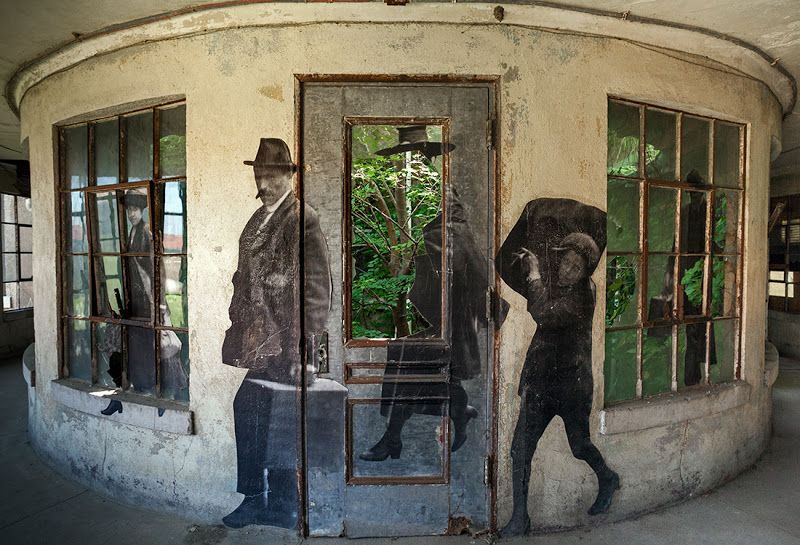
While Ellis Island has become one of New York City’s top tourist attractions, drawing over two million visitors per year, the 22-building South Side hospital complex is hidden in plain sight, just to the left of disembarking passengers headed towards the Great Hall. One of the largest public health undertakings in American history, the complex once served as the standard for United States medical care. But that’s difficult to imagine today given its skeletal frame, which has been left to decay for nearly 60 years.
Despite its current state, however, the walls of the hospital continue to reverberate with history, untold stories and amazing facts. That’s why Untapped Cities hosts tours there in partnership with Save Ellis Island, the organization responsible for the preservation of the island. Every week, we bring our readers behind-the-scenes for a truly unique exploration of the abandoned facility, where they have the opportunity to access the hospital’s contagious disease wards, its autopsy rooms and other exclusive places usually closed to the public.
As a teaser for our tour, which you can purchase tickets for below, we’ve rounded up some of our favorite secrets about the hospital complex: Behind-the-Scenes Hard Hat Tour of Ellis Island Hospital
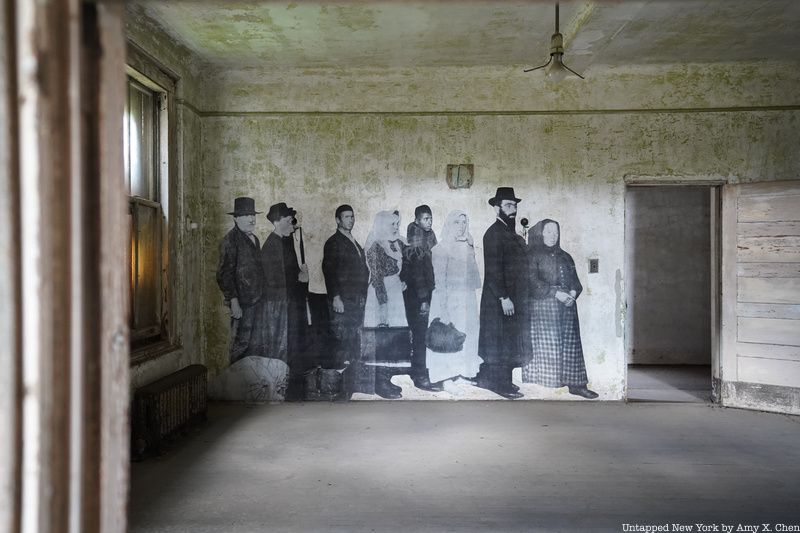
Walking the hallways of an abandoned hospital would give anyone shivers. But what if apparitions from times past unexpectedly appeared in the adjoining rooms, windows, and staircases? Scattered within the South Side hospital complex on Ellis Island, you can spot Unframed, an installation by Parisian street artist JR that opened on October 1, 2014. JR is known for his installations of large-scale photographs in places accessible to the public like New York City’s Times Square, the Pantheon in Paris, and the favelas of Brazil. For this project, he partnered with Save Ellis Island and blew up photos from the island’s archives to paste on the walls of the hospital.
This means that all the images you see on view were actually captured on Ellis Island. Only one, however, is presented in the very spot the photograph was taken. It’s of the hospital’s psychopathic ward (psychiatric ward), which has a caged-in porch area (see above). Learn more about the installation here.
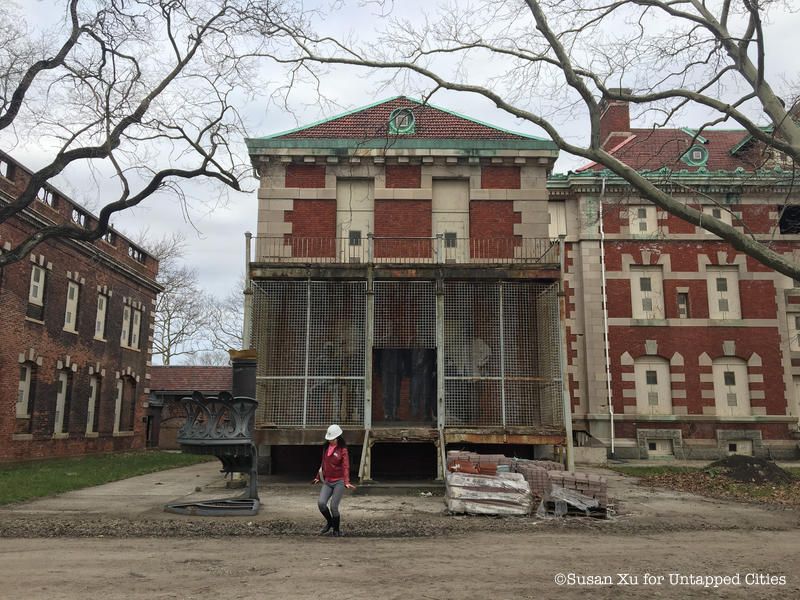
Our tour participants are often confused by the strange-looking sculpture that sits right in front of the psychopathic ward. Turns out, it’s actually a 1 to 1 scale replica of a portion of the Statue of Liberty’s torch (one-eighth of it to be exact). According to docents from Save Ellis Island, the National Park Service, which operates Ellis Island and Liberty Island (Statue of Liberty), sometimes uses the hospital complex as makeshift storage grounds for items it doesn’t know what to do with.
The replica was created by French artisans for display use to show the movement of the torch and the structure of the armature. Additionally, as we learned from a self-proclaimed “Liberty geek” and former park ranger, it allows people to see details of the torch up close. When the 26,000-square-foot Statue of Liberty Museum opens on Liberty Island in 2019, the sculpture will be moved and placed there for public viewing. In the meantime, you can check out renderings of the forthcoming site here. We were also lucky enough to check out the progress of the museum during its topping out ceremony back in December.
The history of New York City’s oysters is a tragic one. Dredging, pollution, and overharvesting throughout the last four centuries have almost entirely decimated New York’s oyster supply, which once counted 220,000 acres of oyster beds. Improbably, given the city-wide partnerships for oyster restoration, there is once again hope for the reefs.
The Billion Oyster Project began in 2012 and hopes to restore one billion oysters to New York Harbor by 2030. To accomplish this lofty goal, it hosts educational activities, restaurant recycling initiatives, and other related programs throughout the city. To date, the initiative has returned around 20 million oysters to the harbor, primarily around Governor’s Island and at the mouth of the Bronx River. Untapped Cities guide Mandy Edgecombe also tells us that there some cages for oyster babies located on the south side of Ellis Island. The location makes sense since the island used to be home to large oyster beds, which served as an important source of food for Native Americans. In fact, the Dutch once called Ellis Island the Little Oyster Island and Liberty Island the Great Oyster Island.
As another extension of its programming, the Billion Oyster Project also partners with the New York Harbor School, a public maritime high school that instills the “ethics of environmental stewardship and the skills associated with careers on the water.”
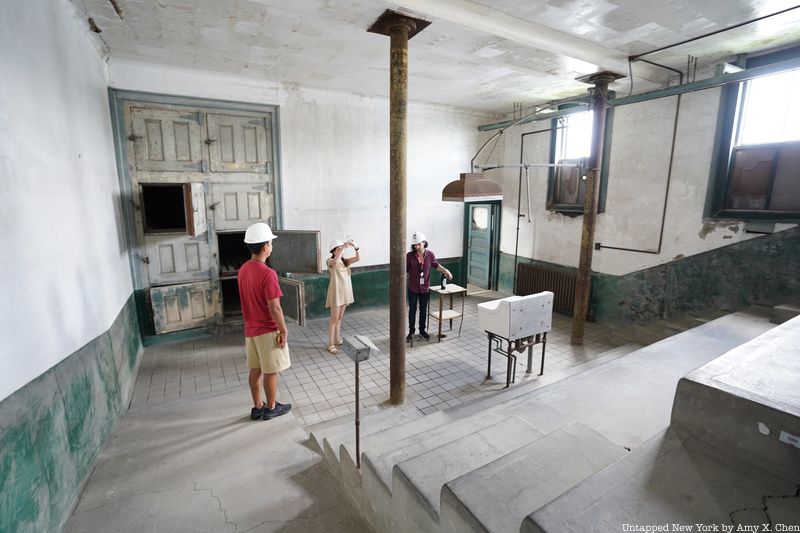
If you scrolled through the various photographs of the Ellis Island hospital complex, you may have noticed that the various wards have no sharp corners. This unique design feature was not an arbitrary aesthetic decision. Remember that the latest theories in healthcare were implemented at the facility — the corners were purposefully rounded because it was thought at the time that sharp corners could trap germs that would allow diseases to fester.
It is for this same reason that bedsheets were washed, dried, and then placed directly on the beds within the hospital. After all, folds leave behind creases, which could trap bacteria and lead to bedsores.
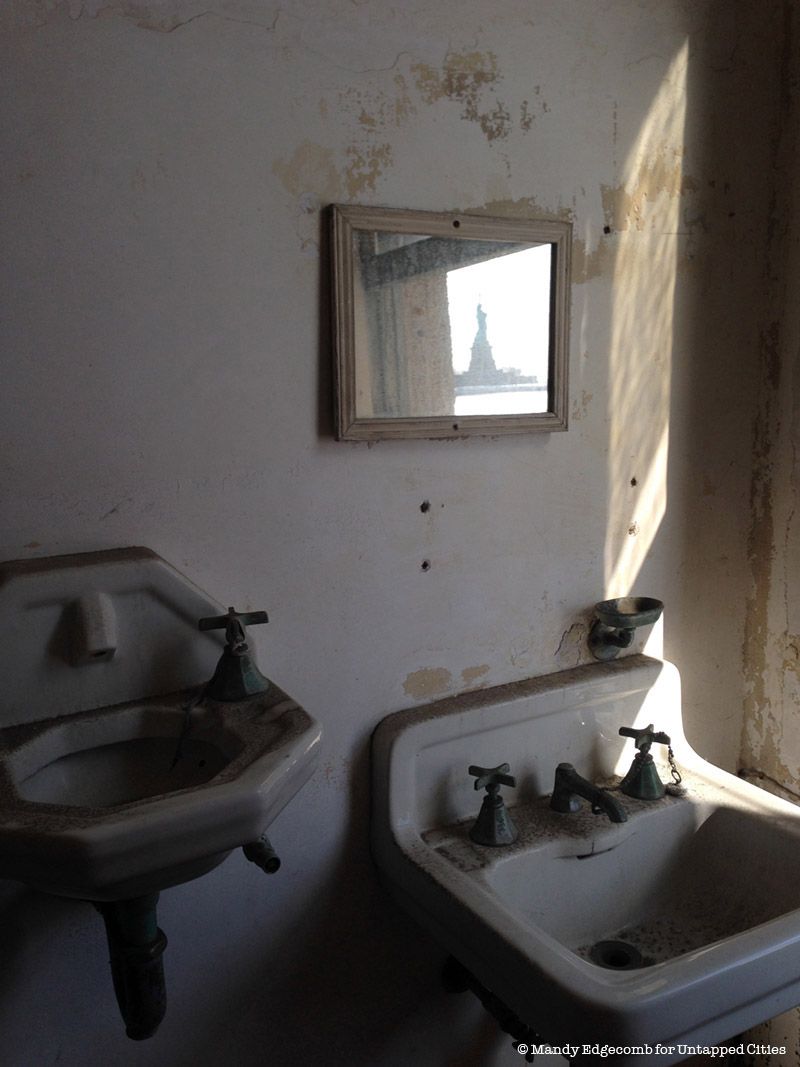
The “money shot” of the Ellis Island hospital complex is located inside one of the Isolation Wards on Island 3. By tilting your camera at just the right angle, you can capture the Statue of Liberty in the reflection of the still hanging mirror in the room. We won’t reveal the exact location, but the double sinks provide a hint of what the room was formerly used for.
According to the National Park Service, the higher wall sink was most likely utilized as a spitting vessel for Tuberculosis patients with the spigot used to clean the entire sink. Many of our tour participants, however, have offered up humorous theories as to what they believe the sinks could be used for. (Someone always guesses that the lower sink is a urinal.)
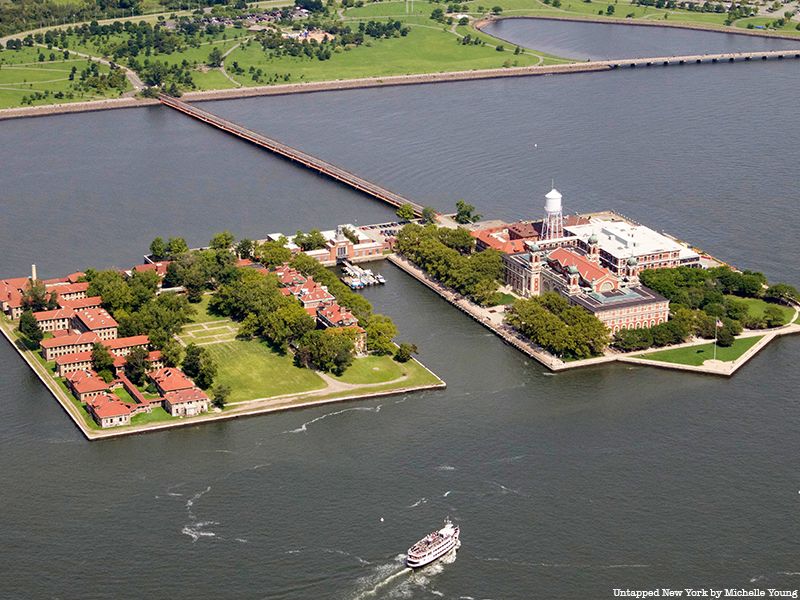
Did you know that the only natural part of Ellis Island spanned just 3.3 acres? Between the years 1903-1910, two new islands were constructed in order to create additional space there, bringing the island’s present-day footprint to roughly 27.5 acres. The foundation upon where the abandoned Ellis Island hospital currently stands is actually man-made — built out of landfill that was excavated during the construction of the New York City subway (we host a tour there too).
The 22 buildings of the hospital were spread out over the two southern islands (Islands 2 and 3), with Island 2 housing the hospital administration and contagious diseases ward, and Island 3 housing the psychiatric ward. However, the space between the islands was eventually filled in during the 1920s to create the base for what was to become a great lawn. That’s because it was believed that fresh air and sunlight were vital for the treatment of diseases. Also, read about other man-made islands here.
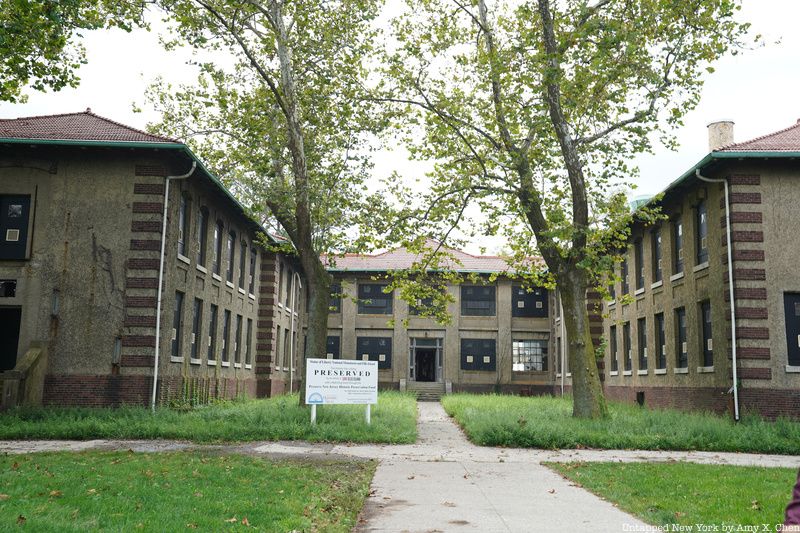
As the largest public hospital in the country and the nation’s most advanced medical facility at the time, the Ellis Island hospital complex welcomed both medical students and established doctors, who traveled from across the country to learn about new treatments and watch operations take place there. The hospital was able to achieve such a reputation not only due to the various hygiene precautions the staff took but also as a result of its design.
You’ll notice in photographs (and in the map above) that the hospital was built with several pavilions extending off a central hall, aptly nicknamed the “spine.” This unique design (“Pavilion Style”) was developed, in part, by Florence Nightingale who advocated for hospital reform. In order to reduce the possibility of cross-contamination, the pavilions are staggered — meaning no two rooms directly face each other. The patient rooms were also placed at the back of each pavilion, where they were the furthest from the central hall.
Another popular architectural practice in these types of hospitals at the time was curved halls. According to The Kingston Lounge, curved hallways had two purposes. First, “their curvature made it impossible to place beds in the connector hallways, which was a common practice at overcrowded hospitals of the era. At the same time, it allowed a greater level of supervision, as doctors and nurses could easily traverse the entire length of the complex, while orderlies and patients could be confined to a single ward.”
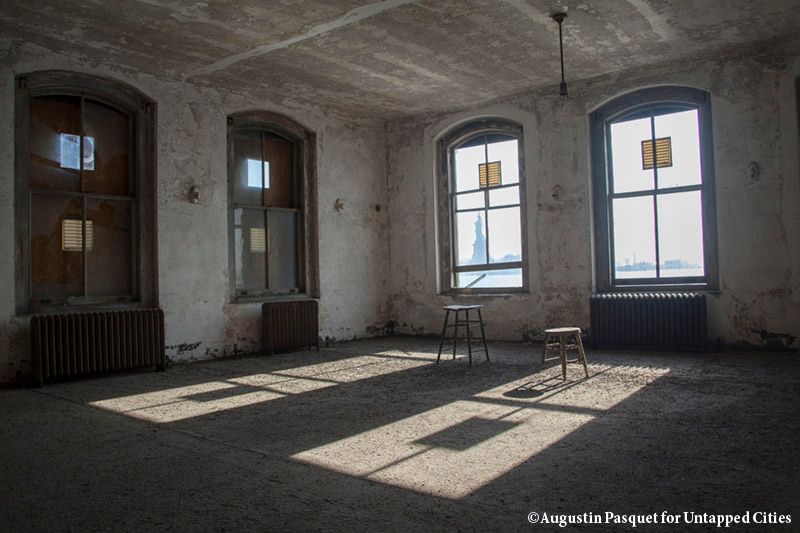
Up until it shuttered, the Ellis Island hospital complex had serviced over 1 million people. Impressively, nine out of the ten people that were admitted were ultimately cured and allowed to enter the United States. However, the future wasn’t always so bright for some patients. Although the facility was equipped with the latest, state-of-the-art technologies, 3,500 immigrants did die in the facility.
The room above, housed inside the Contagious and Infectious Disease Ward, is where patients were brought to if there was no hope for treatment. This was purposeful, as it provided what was regarded to be the best view in the hospital, providing a direct vantage point of the Statue of Liberty. In fact, the rooms with better views were often reserved for those with grim diagnoses.
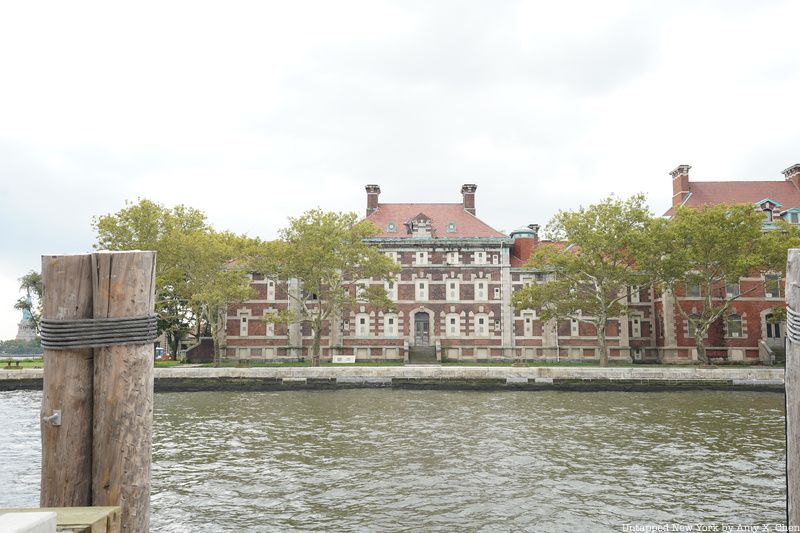
The Ellis Island hospital didn’t always serve as a health facility. After it closed in 1930, the FBI briefly utilized the space as a field office. During World War II, military detainees, including German and Italian prisoners of war, were housed on the islands, and wounded U.S. soldiers were also treated there.
Then from 1939 to 1946, the United States Coast Guard occupied Ellis Island and established a training station there. The hospital complex and recreation buildings were used as offices until 1954, when the Coast Guard officially abandoned the site, leaving behind medical equipment and furniture.
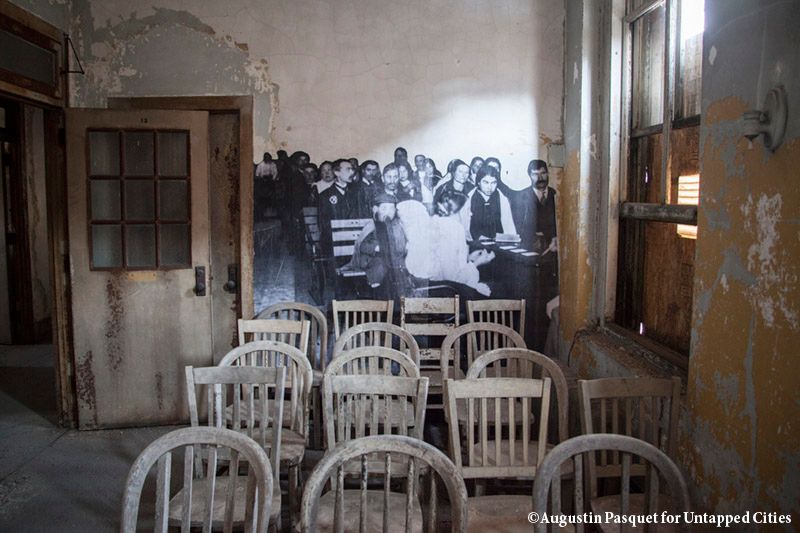
One of our favorite fun facts we learned while exploring Ellis Island was that the word “moron” was actually popularized at the hospital complex. American psychologist Henry H. Goddard is credited for inventing the term in 1910, during an annual meeting of the American Association for the Study of the Feeble-Minded where he proposed a system for classifying individuals with mental retardation based on their IQ.
Under his system, a “moron” was someone with an IQ of 51-70; an “imbecile” had an IQ of 26-50 an and “idiot” had an IQ of 0-25. His inspiration for the word came from a Greek root, “moros,” meaning “dull” or “foolish. In 1913, Goddard sent assistants to Ellis Island to identify and parse out “morons.” He instituted his IQ testing system there to keep “feeble-minded” immigrants from passing through to the United States.
Next check out the Top 10 Secrets of Ellis Island and of the Statue of Liberty. Also, check out our previous exploration inside the hospital.
Subscribe to our newsletter